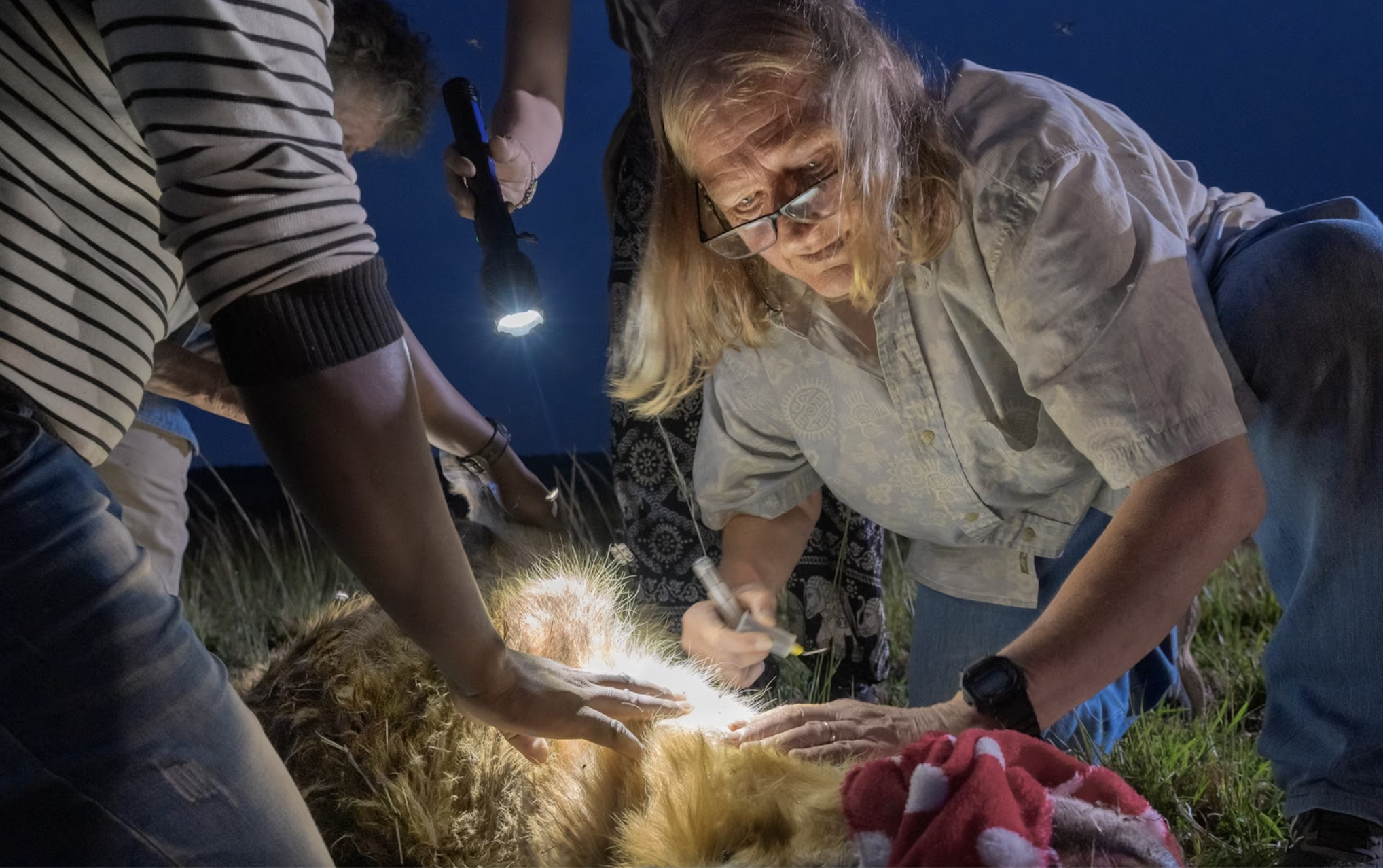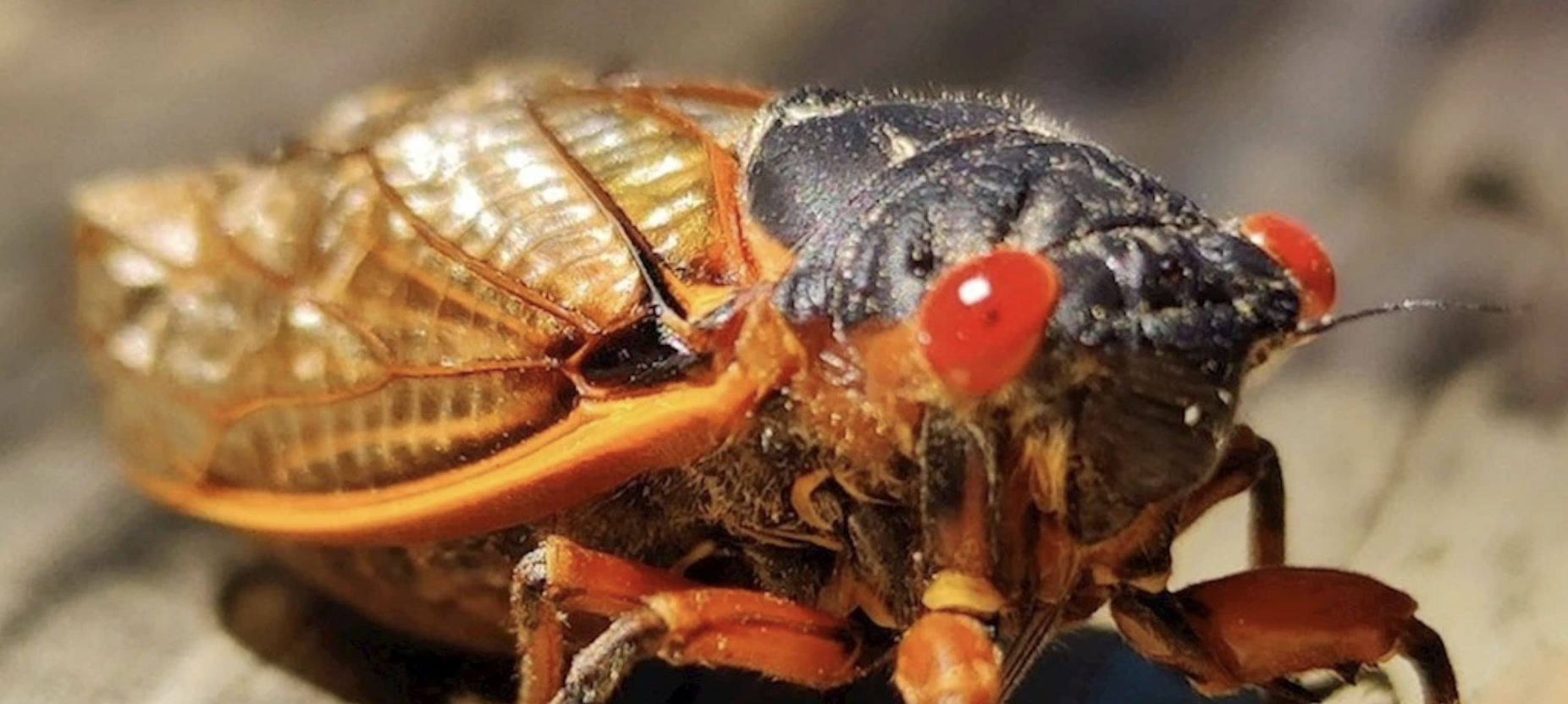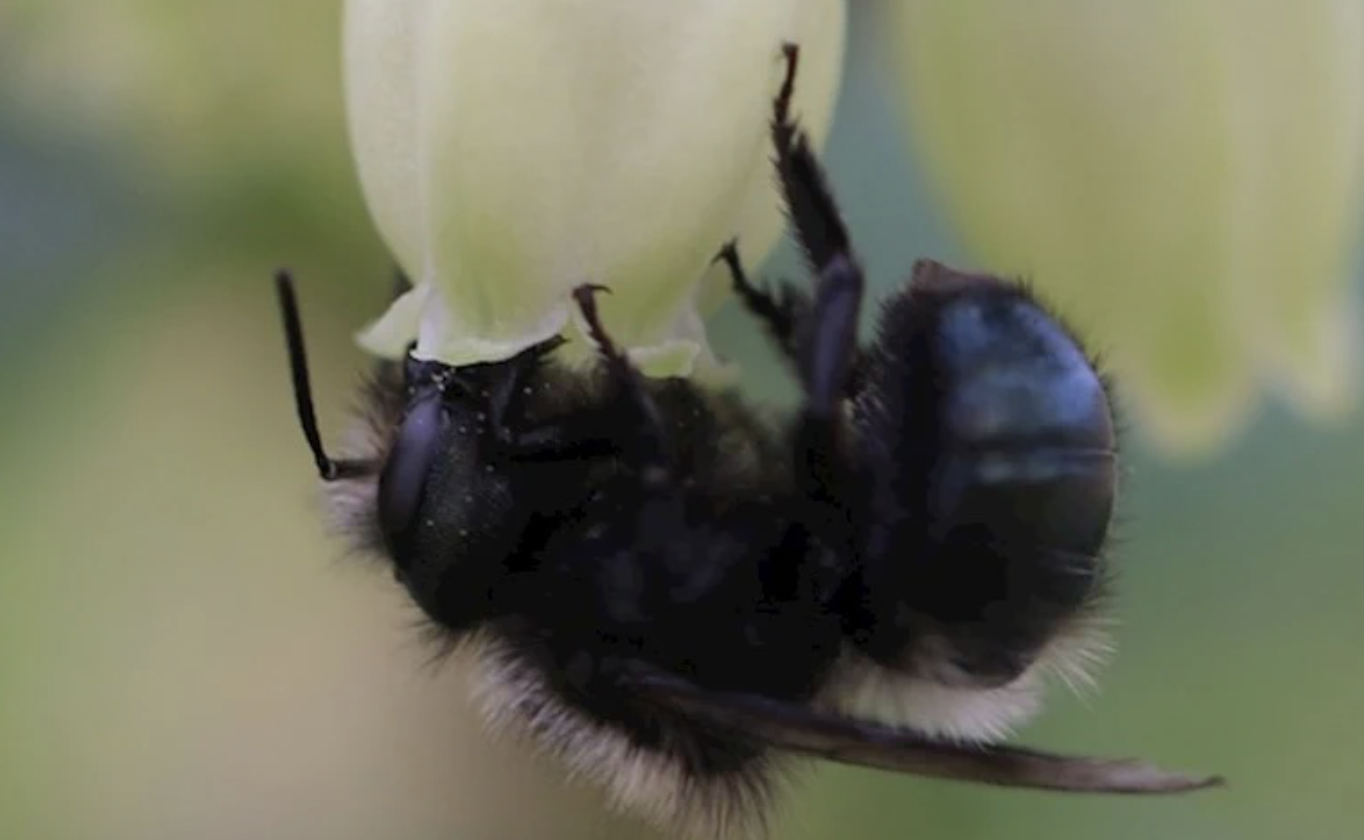Hyenas are getting the last laugh
Thunderclouds rolled across Kenya’s Masai Mara savanna as the spotted hyena cubs played, tumbling over each other in the wet grass. The cubs’ mother lounged nearby, rising occasionally to discourage a bigger one-year-old from joining the little play group. When the older animal approached again, one of the pluckier cubs took a cue from its high-ranking mom and stood tall, trying its best to look intimidating. That action seemed comical, but both animals knew their place. The larger, lower ranking hyena stopped short, then bowed its head and slunk off.
Photographer Jen Guyton recorded this scene with an infrared camera, allowing an intimate look into hyenas’ nocturnal behaviors. In doing so, she provided a small window into the intriguing structure of hyena society, where all members inherit their place in the pecking order from their mother. Females are in charge, and rank means everything—a matrilineal system that has fueled the spotted hyena’s rise as the most abundant large carnivore in Africa.
These and other insights into hyena behavior wouldn’t be possible were it not for 35 years of on-the-ground research by Kay Holekamp, founder of the Mara Hyena Project. Her efforts have helped reveal a creature noted for its advanced society, cognition, and ability to adjust to new surroundings.

Holekamp, a biologist at Michigan State University and EEB core faculty member, has been studying the African species in the Masai Mara since 1988—one of the longest running investigations of any mammal ever. “I thought I’d be there for two years,” she says, “but I got hooked.”
Hooked on hyenas? Mention their name, and most people grimace. Aristotle described them as “exceedingly fond of putrefied flesh.” Theodore Roosevelt called them a “singular mixture of abject cowardice and the utmost ferocity.” Across Africa, hyenas are seen as evil, greedy, and associated with witchcraft and sexual deviance. Even the 1994 movie The Lion King portrayed them as cunning and malicious.
While four hyena species—brown, striped, spotted, and aardwolves—roam through various parts of Africa, the spotted has been the most maligned. One reason may be that the animals get a little too close for comfort.
“Rats, cockroaches, coyotes—all these different things—we just come into contact with them more,” says National Geographic Explorer Christine Wilkinson, a carnivore ecologist at the University of California, Berkeley, who studies hyenas in Kenya’s Lake Nakuru National Park. “Your most vilified species are often the ones that live alongside people, so those that are generalists and adaptable.”
As Wilkinson, Holekamp, and other researchers unravel more about spotted hyenas’ biology and behavior, they continue to upend our understanding of who rules the wild kingdom and how they do it.
It’s a classic safari moment: A lion stands over a fresh carcass while hyenas skulk at the periphery, heads low. The lion has made a kill, and the hyenas are awaiting their chance for scraps, right? Not exactly.
When biologist Hans Kruuk began studying hyenas in Tanzania in the 1960s, he discovered that their reputation as cowardly scavengers was a myth. When spotted hyenas and lions shared a carcass, he found, it was the hyenas that scored the kill more than half the time. More recently, researchers in Kenya have learned that hyenas in the Masai Mara get an average of two-thirds of their food primarily by hunting, often working together seamlessly to take down wildebeests, zebras, buffalo, and other large prey.
How they choreograph these hunts is still a mystery. So in late 2022 Holekamp and colleague Ariana Strandburg-Peshkin from the University of Konstanz in Germany outfitted an entire hyena clan with GPS collars featuring microphones and accelerometers to analyze their movements and vocalizations—including the trademark hyena laugh, which likely expresses great excitement.
“The collars allow us to know where everyone is, who is saying what to whom, which group mates respond and which do not, and what all the hyenas are doing,” Holekamp says. All these data are now being run through AI algorithms to decipher specific behaviors.
One thing has long been clear: Hyena queens are the “backbone of hyena society,” Holekamp says. Part of that matrilineal dominance is physiological. Both female and male fetuses of higher-ranking females are imbued in the womb with a boost of sex hormones such as testosterone, which likely increases aggression.
Another part is anatomical: As the only mammal without an external vaginal opening, female spotted hyenas have an elongated clitoris that hangs between their legs and strongly resembles a male’s penis. During mating, the female retracts this “pseudopenis” into her abdomen, making it impossible for the male to gain entry without her cooperation and ensuring that she decides who fathers her offspring. (Remarkably, the female will also give birth through her clitoris.)
“They’re like a chimera—a blend of multiple organisms,” Holekamp says. “Some of their behaviors are heavily masculinized, and others are not.”
Females care for their young for several years, longer than any other African predator. During this time, the young hyena’s skull is developing, so it’s unable to hunt and kill large prey. Holekamp theorizes this prolonged dependence may be one reason female hyenas evolved to be more aggressive than males, which play no role in parenting.
Though cubs of both sexes inherit the rank of their mother, they fall lower in the hierarchy as new siblings are born. Tagging and tracking studies have also revealed that most males, starting around three years old, leave their birth clans to join another, a strategic choice that can raise their chances of mating and passing on their genes.
Several years ago, Holekamp’s colleague Lily Johnson-Ulrich, a cognitive ecologist from the University of Zürich, drove into the city of Mekele in northern Ethiopia, where hyenas have lived alongside people for hundreds of years. There, she identified appropriate study locations and unloaded a “puzzle box,” a 16-inch square, steel container with four small doors. Inside was a piece of raw meat or some milk powder, and each door required a different motor skill to open it: push, pull, slide, or draw out.
Her team conducted trials at three sites: a city where hyenas had long been resident; a rural, protected reserve; and a burgeoning town on the edge of the reserve where hyenas had lived for only about 20 years. In each spot the team videotaped what happened next from behind their vehicle.
When they tallied the results, they were floored. Based on multiple trials, the rural animals were more adept at opening the doors—a measure of innovation—than were the town and city dwellers. This discovery, published in 2021, runs counter to the theory that urban animals are better problem solvers.
Although hyenas are simply smart to begin with, regardless of where they live, Johnson-Ulrich suspects it’s more than that: While urban hyenas tend to scavenge more and kill livestock, rural hyenas hunt more of what they eat, requiring more innovative thinking and dexterous motor skills.
In earlier experiments, including one in which Holekamp tracked the behavior of a longtime puzzle-box champion named Gucci, it became clear that hyenas can also remember how they solved earlier problems.
“As soon as Gucci saw us put the baited puzzle box on the ground, she arose from her resting site, went directly to the box, and opened it in only a couple of seconds, sliding the bolt holding the door closed backward with her teeth until the box popped open,” Holekamp says.
Arjun Dheer, a wildlife ecologist and National Geographic Explorer who studied hyenas in Tanzania’s Ngorongoro Crater, is also impressed by the species’ cognitive skills. “When you look at a hyena,” he says, “you can see the wheels turning—there’s a lot going on behind those eyes. We underestimate them.”
Hyenas’ teeth and powerful jaws—among the strongest of any mammal—enable them to hunt a wide range of prey and eat as much of it as possible, even the hardest bones. But it’s their built-in innovativeness that has driven the species’ spread and success across the continent.
Clan size depends mostly on the abundance of prey and ranges from fewer than 10 members in some desert areas to around 130 animals at resource-rich sites like the Masai Mara and Ngorongoro Crater. Regardless of their numbers, however, hyenas maintain fission-fusion societies, in which groups of animals split (fission) or merge (fusion) depending on the need of the moment. For instance, some animals may rest and forage solo or in smaller groups, then abruptly join up with a larger group to hunt or defend against attacking lions.
Such fluidity is part of what makes spotted hyenas “the most socially complex carnivores in the world,” says Dheer. Unlike many other African predators, hyenas can also breed anytime and anywhere and raise cubs in habitats that have been degraded by people and their livestock. This flexibility may be why the species has not declined in the same way as have African carnivores that are less able to cope with unexpected stressors.
On a dry, scorching day, Wilkinson steers a beat-up, teal 4x4 through Soysambu Conservancy, a rural area on the outskirts of the Kenyan city of Nakuru. The country’s long-standing drought is obvious; the grass is brittle from lack of rain, and Lake Elmenteita, known for its flocks of lesser flamingos that sometimes fall prey to hyenas, is quiet and still, with no birds in sight.
About 37,000 people live next to the conservancy, which is popular for wildlife tourism, but at least one animal continues to cause some concern. “When you are interviewing people here, asking them about their experiences of conflict,” Wilkinson says, “hyenas come out on top in almost every conversation that you have.”
In a recent study, Wilkinson attached GPS collars to seven hyenas, and now she opens her laptop to see where they’ve traveled overnight. By reviewing GPS data and thousands of camera-trap images, she has discovered that at night hyenas regularly leave Lake Nakuru National Park—one of only two fully fenced national parks in Kenya—and head toward neighboring communities between the park and the conservancy to eat butchers’ scraps and carcass waste. They’ll also occasionally kill and eat livestock not held in predator-proof enclosures, returning to the safety of the park in the morning. Once hyenas find a hole in the fence, they perform what Wilkinson jokingly calls a “downward-facing hyena” to squeeze themselves through.
Her fieldwork shows that when rangers fix the fence, the hyenas quickly go to work dismantling the repair, often opening the same hole—making it a challenge to keep this clever species at bay. The fence cameras have also captured funny moments, such as hyenas sliding easily under the perimeter early in the night but struggling to do so on the way back because of their bulging bellies.
Wilkinson’s research demonstrates how readily spotted hyenas adapt to living alongside humans and how they can deftly tackle roadblocks, such as finding work-arounds in fences that people rely on to keep them out.
(Hyenas once stalked the Arctic, fossils reveal.)
As human settlements increasingly abut hyena habitat, the animals have learned to actively avoid people in some situations. Dheer’s research revealed that hyenas living in Ngorongoro Crater were not bothered by herders who move their livestock across the landscape. These hyenas’ cortisol, or stress hormone, levels were the same when compared with those of hyenas in the crater not visited by people, and their fertility and ability to rear young were unaffected.
In fact, Ngorongoro hyenas have learned to anticipate and avoid people’s movements by becoming more active at night. “Not every animal can make such a change without negative consequences, but hyenas can,” Dheer says. “They’re able to use every inch of the landscape and find a way to survive and persist even in places where they’re really disliked.”



